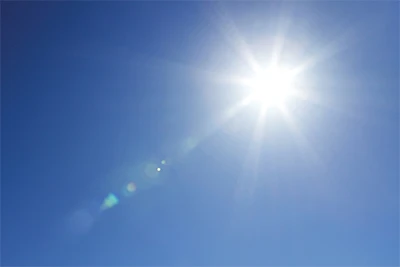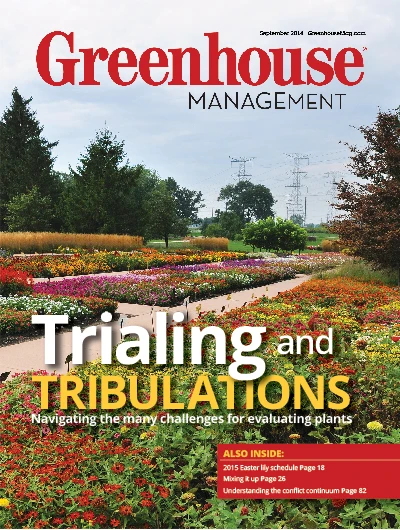
 Greenhouse growers around the world are converting their greenhouses from traditional incandescent lighting – usually power-hungry, high-pressure sodium (HPS) or metal halide (MH) high-intensity discharge (HID) gas lamps – to more energy-efficient “intelligent” LEDs (light emitting diodes), a light source based on semiconductors. The cooler, more energy efficient LEDs – initially more expensive than HPS lamps but costing less in the long run – are bringing affordable sun-like light directly to greenhouse crops.
Greenhouse growers around the world are converting their greenhouses from traditional incandescent lighting – usually power-hungry, high-pressure sodium (HPS) or metal halide (MH) high-intensity discharge (HID) gas lamps – to more energy-efficient “intelligent” LEDs (light emitting diodes), a light source based on semiconductors. The cooler, more energy efficient LEDs – initially more expensive than HPS lamps but costing less in the long run – are bringing affordable sun-like light directly to greenhouse crops.
Just as plants have different needs when it comes to feeding and watering, the same is true when it comes to lighting. It’s up to greenhouse growers to incorporate systems that effectively meet the various lighting needs of their plants.
“One solution is the use of intelligent wavelength controls like auto-spectral tuning and optimization,” says Chris Walker, general manager USA, Heliospectra AB, a Swedish-based LED system manufacturer with U.S. headquarters in San Francisco.
“When you make the light quality of the LED systems consistent with the action spectrum of photosynthesis and key plant receptors, this enables growers to maximize yields by customizing their operations at the individual plant level,” says Walker. “This means that each greenhouse crop gets essential light where and when it needs it, so that it can be at its best by harvest time. We believe the key to an effective greenhouse LED lighting system is ‘built-in intelligence,’ for controlling the intensity of the light’s wavelengths to match each plant’s needs.”
According to Kevin Wells, CEO of LumiGrow, Inc., a Novato, Calif.-based maker of networked LED crop lighting systems, the most significant change over the past several years is that LED lights have moved firmly from the future to the here and now.
“Our customers, many of whom never used lights before, are reporting ROI within three years or less,” Wells says. “Even better, they start saving with their first power bills.”
There’s more
LEDs, of course, aren’t the only lighting option for growers. In fact, high-pressure sodium (HPS) or metal halide (MH) high-intensity discharge (HID) gas lamps remain the primary light sources used for indoor plants, both commercially and in the home-hobby market. Both HPS and MH provide a broad spectrum of light similar to the sun’s spectral range (visible light, UV radiation and infrared light heat), which is imperative for proper plant growth.
“HID still offers the best combination of light energy for plants to maximize quality plant growth,” says Rob Freitag, marketing vice president for EYE Hortilux, a Mentor Ohio-based maker of HPS grow lights. “When compared watt-for-watt, LEDs do not have the same spectral intensity as HID,” says Freitag.
 Another LED rival is induction lighting. Rather than using electrodes or filaments – typically the first failure points in a fluorescent lamp – induction lamps use magnets to conduct electricity and create illumination.
Another LED rival is induction lighting. Rather than using electrodes or filaments – typically the first failure points in a fluorescent lamp – induction lamps use magnets to conduct electricity and create illumination.
Most commercial greenhouse growers have little understanding of lights and how they can benefit their business,” says Cary Senders, CEO of iGrow, a Beachwood, Ohio-based induction lighting manufacturer. “Most who switch to LEDs do so primarily for cost-savings on electricity and longevity purposes.”
Growers understand the limitations and extreme cost of HIDs, so they focus on those two issues when evaluating LEDs, Senders opines. “But they’re not really understanding how light can change their entire operation if it’s used to address key issues and bottlenecks in their business,” he says. “It all starts by fully understanding a grower’s current limitations with light.”
He emphasizes the opportunities for year-round productivity now available to users of the new lighting technologies.
“We want growers trying crops they don’t typically grow,” says Senders. “We urge growers – particularly flower growers – to consider going in a strong direction to grow leafy greens like micro greens, baby greens and lettuce … these are easy and fast to grow and can be sold all the time.”
Ned Madden is a California-based Controlled Environment Agriculture (CEA) consultant, marketing professional and journalist who writes about urban agriculture technology and business-related topic.

Explore the September 2014 Issue
Check out more from this issue and find your next story to read.
Latest from Greenhouse Management
- CEA Alliance celebrates bipartisan introduction of Supporting Innovation in Agriculture Act
- Dümmen Orange North America celebrating 25th anniversary in 2025
- Illinois Landscape Contractors Association changes name to Landscape Illinois
- 2025 Proven Winners Horticulture Scholarship applications now open
- ICL’s Gemini Granular herbicide now registered for use in California
- Eurazeo Planetary Boundaries Fund acquires Bioline AgroSciences
- Spring Meadow Nursery's Freedom Shelley finds joy in plants
- Leading Women of Horticulture: Dana Massey, Plantworks Nursery






